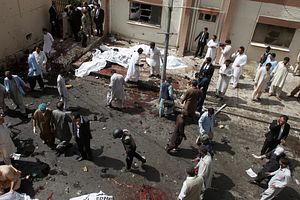At least 70 people were killed when Quetta’s Civil Hospital was targeted for an attack on Monday. Quetta is the capital of Pakistan’s volatile Balochistan province, which is the hub of a separatist movement, a military operation, and a freely operating jihadist network. In May, the previous Afghan Taliban leader Mullah Mansour was killed in a U.S. drone strike in the province.
Both Islamic State (ISIS) and the Taliban faction Jamaat-ul-Ahrar (JA) have claimed responsibility for Monday’s bombing, which targeted protestors that had gathered in the local hospital to demonstrate against Balochistan Bar Association President Bilal Anwar Kasi’s killing. It is not the first time ISIS and a Taliban faction have unanimously owned a terror attack. In May last year ISIS and Jundallah claimed responsibility for killing 43 members of the minority Ismaili Shia community in a bus attack in Karachi.
JA and ISIS go back a long way. It was in fact the Middle Eastern outfit’s rise that inspired Abdul Wali, alias Omar Khalid Khorasani, a Taliban commander affiliated with al-Qaeda, to carve out his own faction from the Pakistani Taliban. Since then JA has orchestrated multiple bombings in Pakistan targeting – among others – the Wagah border, Youhanabad churches, Charsadda district court, and Gulshan-e-Iqbal Park in the past 24 months.
A close look at JA’s attacks reveals that it has successfully targeted all four major provinces of the country. The Taliban faction has specifically targeted Lahore, the capital of Punjab and the nucleus of the ruling Pakistan Muslim League-Nawaz (PML-N) party. Furthermore, the JA – like other Taliban factions – is going after “soft targets” like parks, schools, polio centers, and hospitals, targeting vulnerable groups like religious minorities and attacking professionals that are already in the line of fire, like lawyers in Charsadda or Quetta.
Last month, Omar Khorasani was taken down in a U.S. drone strike in Nangarhar, Afghanistan. Khorasani was the mastermind of the 2014 Peshawar school attack that had seemingly united the political and military leadership in the fight against jihadists in general and the Pakistani Taliban in particular, resulting in a formal counterterrorism policy, christened as the National Action Plan (NAP). JA continuing from where Khorasani had left off not only signifies the effectiveness of the JA founder’s strategy; the Quetta bombing also is a clear statement of intent.
The Pakistani Taliban, especially JA, are hunting softer targets because they leave deeper scars in a war that is defined by psychological skirmishes. While the Taliban’s maneuvers have been dismissed as a desperate sign of the jihadist group’s diminishing clout, the strategy’s continued success reveals it as an effective modus operandi that is yet to be countered by the Pakistani security agencies.
Through a surge in attacks on schools, children’s parks, hospitals, and professionals, the Taliban seek to weaken the spirits of the nation following last year, which was the “most peaceful” in almost a decade, with success stories of the NAP and Military Operation Zarb-e-Azb in the northwest of the country being churned out for the masses’ consumption.
Furthermore, the ISIS label on bombings in Quetta, Karachi, and other parts of the country, allows many Taliban factions to self-aggrandize as a part of a global jihadist threat, at a time when both the military and the government are rehashing statements claiming that the Taliban’s backbone has been broken. What better way to rubbish those claims than to allow the world’s most illustrious jihadist group to conspicuously have your back?
Despite ISIS not having any operational presence in South Asia, this jihadist symbiosis allows the Islamic State to exaggerate its reach, while giving the Taliban faction a marker to further demoralize the masses and an enviable selling point for local recruitment in the ongoing war on terror. In this psychological warfare, the jihadists clearly have thought their course of action through, more so than their foes.
What further aids the Taliban’s plan is the Pakistani state continuing its duplicity on jihadist groups, despite its claims of having abandoned the “Good Taliban, Bad Taliban” policy. Not only are eastbound jihadist groups being allowed to masquerade as Kashmir’s liberators on both sides of the India-Pakistan Line of Control, the leaders are pointing fingers toward India for an attack vocally claimed by two separate jihadist groups.
While the Pakistani security agencies’ preference for confessing incompetence vis-à-vis “RAW’s manipulation” seems to contradict the state’s peddling of India as the enemy number one, this masochistic policy’s sole aim is to give credence to Pakistan’s aforementioned duplicity on jihadism.
Amid the Taliban visibly denting the nation’s collective morale, the state feels the need to point towards India to distract the masses. This counterproductive “counterterrorism” strategy is handing the Taliban the momentum on a platter.

































